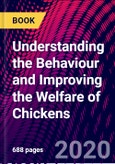`Each chapter provides an overview of current knowledge on the topic in question, accompanied by an outline of advances in both scientific and applied fields. The chapters are written by twenty-five authors, all scientific experts in the subject discussed… In conclusion, Understanding the behaviour and improving the welfare of chickens is an expertly written, widely accessible book for all professionals in the field, which should provide increased understanding of chicken behaviour and welfare.` (Animal Welfare - Universities Federation for Animal Welfare) With rising consumer concerns about the welfare of farm animals, such as chickens, there is a growing urgency for the livestock production sector to ensure that welfare standards are met throughout the supply chain, from breeding to slaughter. Understanding the behaviour and improving the welfare of chickens offers a comprehensive summary on the wealth of recent research completed on understanding chicken behaviour and discusses how best to use this rich body of knowledge to optimise welfare management of broilers and layers. This collection features expert insights into the use of wearable, video and acoustic technologies as a means of monitoring behaviour, as well as improving current welfare protocols. With its distinguished editor and team of leading experts in their fields, Understanding the behaviour and improving the welfare of chickens will be a standard text for university researchers in poultry and veterinary science as well as ethology. The book will also be an authoritative reference for government and other agencies responsible for the poultry sector and farm animal welfare, as well as companies involved in rearing chickens and processing poultry meat and eggs.
Audience: University researchers in poultry and veterinary science as well as ethology; government and other agencies responsible for the poultry sector and farm animal welfare; companies involved in rearing chickens and processing poultry meat and eggs
Audience: University researchers in poultry and veterinary science as well as ethology; government and other agencies responsible for the poultry sector and farm animal welfare; companies involved in rearing chickens and processing poultry meat and eggs
Table of Contents
Part 1 Behaviour1. Advances in understanding the genetics of poultry behaviour: Dominic Wright and Rie Henriksen, IFM Biology - Linköping University, Sweden;
2. Understanding the sensory perception of chickens: Birte L. Nielsen, INRAE, France;
3. Understanding states of suffering with implications for improved management of poultry: Ian J. H. Duncan, University of Guelph, Canada;
4. Understanding chicken learning and cognition and implications for improved management: Rafael Freire, Charles Sturt University, Australia;
5. Understanding poultry social behaviour and its impact on animal welfare: Inma Estevez, Neiker-Tecnalia Basque Institute for Agricultural Research and Development and IKERBASQUE, Basque Foundation for Science, Spain;
6. Poultry welfare monitoring: wearable technologies: Dana L. M. Campbell, CSIRO, Australia; and Marisa A. Erasmus, Purdue University, USA;
7. Poultry welfare monitoring: group-level technologies: Marian Stamp Dawkins and Elizabeth Rowe, University of Oxford, UK;
8. Improving welfare assessment indicators and protocols for poultry: Linda Keeling, Swedish University of Agricultural Sciences, Sweden;
Part 2 Welfare issues in breeding, management and housing
9. Welfare issues affecting broiler breeders: Anja Brinch Riber, Aarhus University, Denmark;
10. Opportunities to improve the welfare of young chickens: Elske N. de Haas, Utrecht University, The Netherlands;
11. Welfare issues in poultry housing and management: broilers: Ingrid C. de Jong, Wageningen Livestock Research, Wageningen University and Research, The Netherlands;
12. Welfare issues in poultry housing and management: laying hens: Victoria Sandilands, Scotland’s Rural College (SRUC), UK;
13. The role of perches in chicken welfare: Lars Schrader and Julia Malchow, Institute of Animal Welfare and Animal Husbandry - Friedrich-Loeffler-Institut, Germany;
14. Improving welfare in catching and transport of chickens: Leonie Jacobs, Virginia Tech, USA; and Frank A. M. Tuyttens, Institute for Agricultural and Fisheries Research (ILVO) and Ghent University, Belgium;
15. Improving welfare in poultry slaughter: Dorothy McKeegan, Institute of Biodiversity, Animal Health and Comparative Medicine, University of Glasgow, UK; and Jessica Martin, The Royal (Dick) School of Veterinary Studies and The Roslin Institute, University of Edinburgh, UK;
16. Cause and prevention of injurious pecking in chickens: Nienke van Staaveren and Alexandra Harlander, University of Guelph, Canada;
17. Bone health and associated problems in layer hens: Christina Rufener, University of California-Davis, USA; and Michael J. Toscano, University of Bern, Switzerland;
18. Poultry health monitoring and management: bone and skin health in broilers: Gina Caplen, University of Bristol, UK








